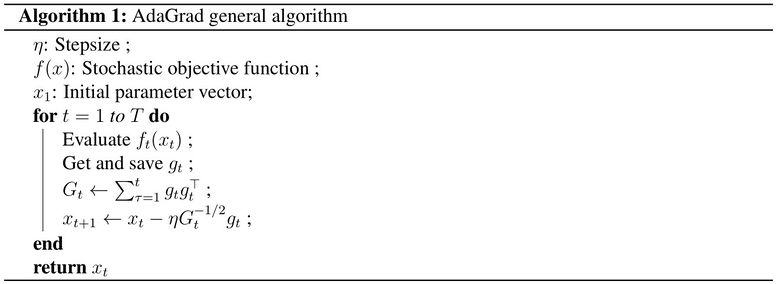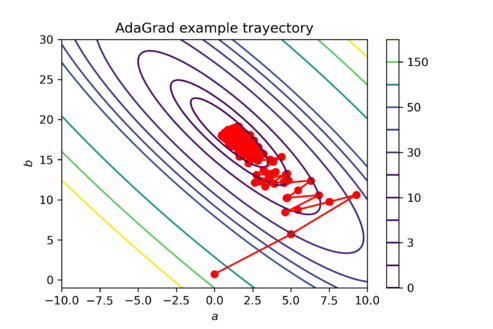AdaGrad: Difference between revisions
| Line 57: | Line 57: | ||
The general version of the AdaGrad algorithm is presented in the pseudocode below. The update step within the for loop can be modified with the version that uses the diagonal of <math>G_t</math>. | The general version of the AdaGrad algorithm is presented in the pseudocode below. The update step within the for loop can be modified with the version that uses the diagonal of <math>G_t</math>. | ||
[[File:NewAlgo.jpg|alt=|center|783x783px|AdaGrad Algorithm]] | [[File:NewAlgo.jpg|alt=|center|783x783px|AdaGrad Algorithm]] | ||
=== Variants === | |||
=== Regret Bound === | === Regret Bound === | ||
| Line 64: | Line 67: | ||
where <math>x^*</math>is the set of optimal parameters. AdaGrad has a regret bound of order <math>O(\sqrt{T})</math>, which leads to the convergence rate of order <math>O(1/\sqrt{T})</math>, and the convergence guarantee (<math display="inline">\lim_{T \to \infty} R(T)/T = 0</math>). The detailed proof and assumptions for this bound can be found in the original journal paper<ref name=":0" />. | where <math>x^*</math>is the set of optimal parameters. AdaGrad has a regret bound of order <math>O(\sqrt{T})</math>, which leads to the convergence rate of order <math>O(1/\sqrt{T})</math>, and the convergence guarantee (<math display="inline">\lim_{T \to \infty} R(T)/T = 0</math>). The detailed proof and assumptions for this bound can be found in the original journal paper<ref name=":0" />. | ||
=== Comparison with other gradient-based methods === | |||
== Numerical Example == | == Numerical Example == | ||
Revision as of 20:22, 13 December 2021
Author: Daniel Villarraga (SYSEN 6800 Fall 2021)
Introduction
AdaGrad is a family of sub-gradient algorithms for stochastic optimization. The algorithms belonging to that family are similar to second-order stochastic gradient descend with an approximation for the Hessian of the optimized function. AdaGrad's name comes from Adaptative Gradient. Intuitively, it adapts the learning rate for each feature depending on the estimated geometry of the problem; particularly, it tends to assign higher learning rates to infrequent features, which ensures that the parameter updates rely less on frequency and more on relevance.
AdaGrad was introduced by Duchi et al.[1] in a highly cited paper published in the Journal of machine learning research in 2011. It is arguably one of the most popular algorithms for machine learning (particularly for training deep neural networks) and it influenced the development of the Adam algorithm[2].
Theory
The objective of AdaGrad is to minimize the expected value of a stochastic objective function, with respect to a set of parameters, given a sequence of realizations of the function. As with other sub-gradient-based methods, it achieves so by updating the parameters in the opposite direction of the sub-gradients. While standard sub-gradient methods use update rules with step-sizes that ignore the information from the past observations, AdaGrad adapts the learning rate for each parameter individually using the sequence of gradient estimates.
Definitions
: Stochastic objective function with parameters .
: Realization of stochastic objective at time step . For simplicity .
: The gradient of with respect to , formally . For simplicity, .
: Parameters at time step .
: The outer product of all previous subgradients, given by
Standard Sub-gradient Update
Standard sub-gradient algorithms update parameters according to the following rule:
AdaGrad Update
The general AdaGrad update rule is given by:
Adaptative Learning Rate Effect
An estimate for the uncentered second moment of the objective function's gradient is given by the following expression:
which is similar to the definition of matrix , used in AdaGrad's update rule. Noting that, AdaGrad adapts the learning rate for each parameter proportionally to the inverse of the gradient's variance for every parameter. This leads to the main advantages of AdaGrad:
- Parameters associated with low frequency features tend to have larger learning rates than parameters associated with high frequency features.
- Step-sizes in directions with high gradient variance are lower than the step-sizes in directions with low gradient variance. Geometrically, the step-sizes tend to decrease proportionally to the curvature of the stochastic objective function.
which favor the convergence rate of the algorithm.
Algorithm
The general version of the AdaGrad algorithm is presented in the pseudocode below. The update step within the for loop can be modified with the version that uses the diagonal of .

Variants
Regret Bound
The regret is defined as:
where is the set of optimal parameters. AdaGrad has a regret bound of order , which leads to the convergence rate of order , and the convergence guarantee (). The detailed proof and assumptions for this bound can be found in the original journal paper[1].
Comparison with other gradient-based methods
Numerical Example

To illustrate how the parameter updates work in AdaGrad take the following numerical example. The dataset consists of random generated obsevations that follow the linear relationship:
| 0.39 | 9.83 |
| 0.10 | 2.27 |
| 0.30 | 5.10 |
| 0.35 | 6.32 |
| 0.85 | 15.50 |
The cost function is defined as . And an observation of the cost function at time step is given by , where are sampled from the obsevations. Finally, the subgradient is determined by:
Take a learning rate , initial parameters , and . For the first iteration of AdaGrad the subgradient is equal to:
and is:
Applications
The AdaGrad family of algorithms is typically used in machine learning applications. Mainly, it is a good choice for deep learning models with sparse input features[1]. However, it can be applied to any optimization problem with a differentiable cost function. Given its popularity and proven performance, different versions of AdaGrad are implemented in the leading deep learning frameworks like TensorFlow and PyTorch. Nevertheless, in practice, AdaGrad tends to be substituted by the use of the Adam algorithm; since, for a given choice of hyperparameters, Adam is equivalent to AdaGrad [2].
Conclusion
AdaGrad is a family of algorithms for stochastic optimization that uses a Hessian approximation of the cost function for the update rule. It uses that information to adapt different learning rates for the parameters associated with each feature. Their main two advantages are that: it assigns more significant learning rates to parameters related to low-frequency features, and the updates in directions of high curvature tend to be lower than those in low-curvature directions. Therefore, it works especially well for problems where the input features are sparse. AdaGrad is reasonably popular in the machine learning community, and it is implemented in the primary deep learning frameworks. In practice, the Adam algorithm is usually preferred over AdaGrad since, for a given choice of hyperparameters, Adam is equivalent to AdaGrad.


































![{\textstyle f(a,b)={\frac {1}{N}}\sum _{i=1}^{n}([a+b\cdot x_{i}]-y_{i})^{2}}](https://wikimedia.org/api/rest_v1/media/math/render/svg/d86302234845f28e7123709faaa4cd93d7260f9d)
![{\displaystyle f_{t}(a,b)=([a+b\cdot x_{t}]-y_{t})^{2}}](https://wikimedia.org/api/rest_v1/media/math/render/svg/6907c9197706539cecb74f1c2b7c4266b99690b1)

![{\displaystyle g_{t}={\begin{bmatrix}2([a_{t}+b_{t}\cdot x_{t}]-y_{t})\\2x_{t}([a_{t}+b_{t}\cdot x_{t}]-y_{t})\end{bmatrix}}}](https://wikimedia.org/api/rest_v1/media/math/render/svg/e1b916a0cb18358a5697db2b4839a506fb886d26)



![{\displaystyle g_{1}={\begin{bmatrix}2([0+0\cdot 0.39]-9.84)\\2\cdot 0.39([0+0\cdot 0.39]-9.84)\end{bmatrix}}={\begin{bmatrix}-19.68\\-7.68\end{bmatrix}}}](https://wikimedia.org/api/rest_v1/media/math/render/svg/f11843be8e8b85c9825f07d0c693a1927eb82c2b)



